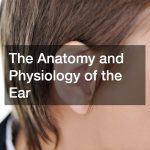
The ear is a remarkable organ that plays a critical role in our ability to hear and maintain balance. Understanding the anatomy and physiology of the ear provides insight into how we perceive sound and how our bodies maintain equilibrium. The ear is divided into three main sections: the outer ear, the middle ear, and the inner ear.
Each part has distinct structures and functions that work together to process sound waves and support balance.
The Outer Ear
The outer ear consists of the pinna (or auricle) and the external auditory canal. The pinna is the visible part of the ear that protrudes from the side of the head. Its primary function is to collect sound waves from the environment and funnel them into the external auditory canal. The shape of the pinna helps to amplify and direct sound waves toward the ear canal, enhancing our ability to detect and localize sounds.
The Middle Ear
The middle ear is an air-filled cavity located behind the eardrum. It contains three small bones known as the ossicles: the malleus (hammer), incus (anvil), and stapes (stirrup). These bones are the smallest in the human body and play a crucial role in the hearing process.
When sound waves cause the eardrum to vibrate, these vibrations are transmitted to the malleus, which is attached to the eardrum. The malleus then transmits the vibrations to the incus, and the incus passes them on to the stapes. The stapes, in turn, transmits the vibrations to the oval window, a membrane-covered opening that leads to the inner ear.
The Inner Ear
The inner ear, also known as the labyrinth, is a complex structure that is responsible for both hearing and balance. It contains two main parts: the cochlea and the vestibular system.
The cochlea is a spiral-shaped, fluid-filled structure that is essential for hearing. When the stapes transmits vibrations to the oval window, these vibrations create waves in the fluid inside the cochlea. The cochlea contains tiny hair cells that convert these fluid waves into electrical signals. These signals are then transmitted to the brain via the auditory nerve, where they are interpreted as sound.
The anatomy and physiology of the ear involve a complex interplay of structures and functions that enable us to hear and maintain balance. Each part of the ear, from the outer ear to the inner ear, plays a vital role in these processes. Understanding the ear’s anatomy and physiology helps us appreciate the complexity of these essential sensory functions and the importance of protecting our hearing and balance throughout life.
.




